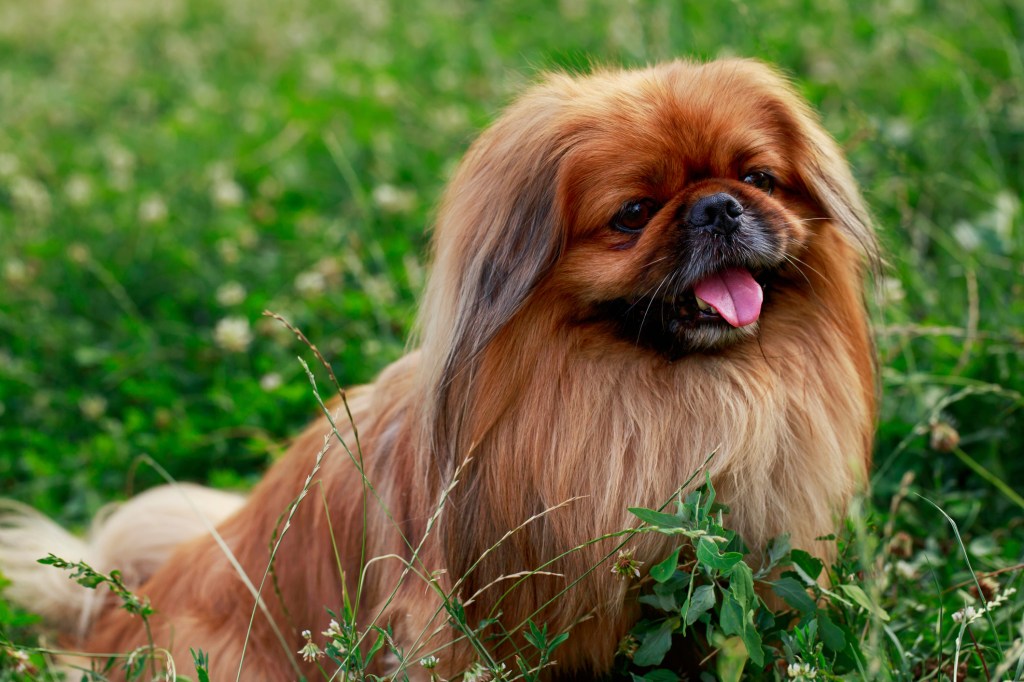While we may often overlook this fact, dogs are largely tied to human history. Certain breeds, like the Doberman Pinscher or Teddy Roosevelt Terrier, owe their existence to visionary individuals. Some others emerge from specific cultures or social classes. With traits adapted to local climates and body styles suited for native terrains, purebred dogs embody living history, reflecting the diverse cultures that shaped them. They provide a glimpse into our world’s cultural heritage and often find themselves entwined in complex human interactions — as seen with the ancient and mysterious Pekingese breed.
As per CNN Style, during the peak of the Second Opium War in 1860, British and French troops climbed the 15-foot walls of Yuanmingyuan, also known as the “Gardens of Perfect Brightness,” in Beijing — known to Europeans as “Peking.” They used imperial silk to tie their horses, smashed invaluable porcelain, and looted both jewelry and artifacts.
Upon receiving word that the peace negotiation had taken a deadly turn with the torture and death of several members of the British-led delegation, a significant number of English soldiers retaliated by demolishing the imperial gardens and palaces that spread across 800 acres. They ignited the exquisite cedar structures, which continued burning for two days. It was an act of cultural devastation so massive it’s often referred to as China’s Ground Zero.
Within the Old Summer Palace, amidst jade carvings and bronze statues, military men discovered unexpected living treasures — five Pekingese dogs. Surprisingly, they weren’t killed to prevent them from falling into foreign hands as the emperor and his family escaped. In fact, they were found in an apartment owned by the emperor’s aunt. She took her own life as the military forces drew near.
Imperial history of the Pekingese dog breed
These pear-shaped, brachycephalic or flat-faced toy dogs were largely unknown beyond their home country of China. There, only the imperial family was allowed to own them. They are said to have originated during the Han dynasty, more than two thousand years ago.
Some scholars suggest the introduction of Buddhism in China influenced the creation of this breed. In Buddhist mythology, lions play a crucial role. Given that Asiatic tigers were extinct in China for a long time, the dedicated Buddhist monks created dog breeds. These breeds — including the Lhasa Apso, Tibetan Mastiff, and, indeed, the Pekingese — embodied lion-like characteristics, such as flat snouts and a plentiful mane.
According to one legend, a lion who was in love with a marmoset monkey pleaded with the gods to reduce his size so his love could be reciprocated. After the transformation, his heart remained unaltered in size.
In contrast, a more recent and equally dramatized portrayal of the Pekingese breed can be found in a long-form poem titled “Pearls Dropped from the Lips of Her Imperial Majesty Tzu-Hsi Dowager Empress of the Flowery Land.” The dowager empress Tzu-Hsi was known to breed Pekingese in her royal kennel along with Pugs and Shih Tzu. However, it remains unclear whether the sought-after Peke attributes mentioned in the poem are genuine, or the product of some enthusiast’s rich imagination. Regardless, the poem still influenced many Western standards for the breed.
The Pekingese had an aura of self-importance in history, for which they are still known today. They lived luxuriously in a marble pavilion on silk cushions, tended by eunuchs. What’s more, they were occasionally even granted an official court rank.
Looty, the Pekingese: An unlikely royal companion

The five Pekingese dogs stolen from Yuanmingyuan were later brought to England. The smallest among them — a fawn and white female adorned with silver bells — was gifted to Queen Victoria. In a less-than-culturally sensitive decision, the queen named her “Looty.”
Captain John Hart Dunne — the man who discovered the dogs in Yuanmingyuan — praised the small Pekingese. He wrote, “People say it is the most perfect little beauty they have ever seen.” In fact, he even let Looty travel to England in his forage cap. Nonetheless, Queen Victoria was reportedly unimpressed by her new pet.
The feeling was apparently mutual as Looty was unhappy with her new surroundings and barely ate. This behavior was quite expected as the dowager empress’s “pearls” indicated that the Pekingese breed is extremely selective with their food. Their diet, which contributed to their identity as imperial dogs, included shark fins, curlew livers, quail breasts, and even the milk of the antelopes grazing in the imperial parks — items that were obviously not available at Balmoral — the place where the queen first met Looty.
The fate of Looty and the four other stolen Pekes
In 1912, the New York Times wrote, “He was a very lonely little creature, the other dogs taking exception to his Oriental habits and appearance.” The account not only played into stereotypes about Looty’s cultural background, but it also misidentified her gender. Looty passed away in 1872 and was laid to rest in an unmarked grave at Windsor Castle.
The other four Pekingese were also given to British aristocrats, although these recipients were considerably more passionate about the pups. The Duchess of Wellington received one pair, whom she named Schlorff and Hytien. The other pair was given to the Duchess of Richmond, Lady Algernon Gordon-Lennox. She started breeding Pekes in her Goodwood kennel and even contributed to writing the first standard.
From Chinese royalty to Western admirers

To initiate breeding programs, more dogs were required, yet the superior dogs were closely guarded by Chinese royals, limiting availability. Nevertheless, some Pekingese made it to the West, either through deception or as a token of goodwill. Reportedly, palace servants and eunuchs were able to sneak out some canines. This was done even though the theft of the highly prized palace dogs was punishable by severe torture and, in some instances, death. In 1896, Ah Cum — believed to be a pioneering sire for the breed — was smuggled to Britain. The dog was hidden in a crate containing Japanese deer.
Towards the end of her life, the dowager empress gave several Pekingese dogs as gifts to notable Americans. These individuals included financier John Pierpont Morgan and President Theodore Roosevelt’s daughter Alice. Additionally, Dr. Frederick Samuel Heuston, an Irish surgeon working in China, was gifted a pair of Pekingese as a token of royal gratitude. This came after he established vaccination clinics that effectively fought smallpox in the area.
Fifty years after the Pekingese breed was introduced to England as war loot, the emerging British middle class started to breed and display these dogs at shows. This boosted the popularity of the Pekingese as a toy breed. Similarly, the breed captivated dog enthusiasts in America. Following the fall of the imperial family in the Chinese Revolution of 1911, the West, ironically, became the protector of these dogs who were highly prized by the ancient aristocracy it had played a part in overthrowing.
The Pekingese dog today
Today’s Pekingese dogs — with their shorter legs, longer hair, and petite faces — are quite different from the ones looted more than a century and a half ago alongside imperial scepters and intricately carved throne chairs.
However, one trait the breed has unquestionably preserved is its sharply developed sense of self. No matter which continent they live on or what language their owners speak, a Pekingese has a clear understanding of their identity — and by implication, your identity too. These dogs, bred for centuries to exhibit dignity and independence, show little concern for the wants of those around them. Remarkably, in a reversal of roles between species, you are their attendant.









